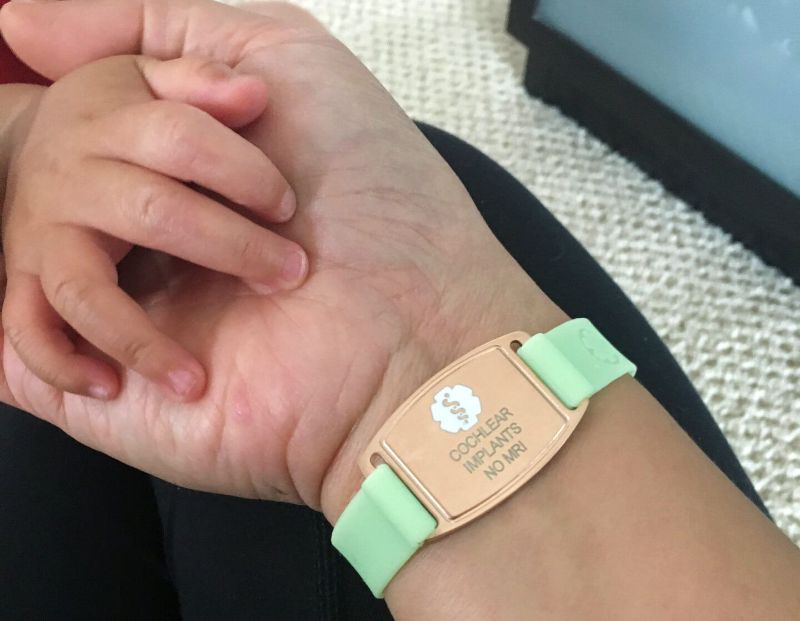|
www.HealthyHearing.com |
I have hearing loss. Should I wear a medical ID bracelet?'Hearing loss is an invisible disability,' one wearer explains
Contributed by Linda Childers When you think of medical ID bracelets, you may envision them being worn by people with medical conditions such as epilepsy or a cardiac issue, yet these bracelets also can benefit children and adults with hearing loss in the event of an emergency. What are medical ID bracelets?
audiologist Michelle Hu, who has profound hearing loss in both ears and wears cochlear implants. Medical ID bracelets are engraved with information such as your name, medical condition, any medications you’re taking, and any allergies. (They are separate products from medical alert bracelets, which serve as wearable alert systems to notify emergency services in the event of a medical crisis.) They are small, discreet, and designed to give first responders important information about your health, in the event of an accident or emergency where you’re unable to communicate. Recommended by the CDCThe MedicAlert Foundation notes that the Centers for Disease Control and Prevention (CDC) recommend those with hearing loss should wear a medical ID bracelet. Michelle Hu, MD, a pediatric audiologist with mama hu hears in San Diego, Calif., often broaches the subject of medical ID bracelets with her patients, knowing how her own bracelet has given her peace of mind. Hu was diagnosed with bilateral hearing loss as a child and was fit with hearing aids for profound hearing loss. Because her hearing loss was progressive, due to enlarged vestibular aqueduct (EVA) and Pendred Syndrome, Hu got cochlear implants as an adult. “After getting my cochlear implants, I started to look into getting a medical ID bracelet,” Hu explains. “If I were ever in an accident and my cochlear implant processors were damaged or fell off, or if I became unconscious or unable to speak, my medical ID bracelet would give first responders all of my important health information.” Invaluable in emergenciesFrom identifying allergies, to providing emergency contact information, medical ID bracelets help to ensure patients receive timely and appropriate care. Information on the bracelets should be reviewed periodically to ensure that your emergency contact and list of medications are current. “Not all cochlear implants are compatible with magnetic resonance imaging (MRI) machines,” Hu says. “My medical ID bracelet notes that I have a cochlear implant and asks that MRI precautions be taken.” Hu says emergency personnel are trained to look for a medical ID bracelet or necklace, knowing it can yield valuable information to help them deliver immediate and appropriate medical treatment. The information listed on these bracelets can impact clinical decision making.
Some come with QR codes for up-to-date info on medicines and more.jpg)
(photo credit: The Leo Loves) On her own medical ID bracelet, Hu lists her name, the fact that she wears cochlear implants (as well as the brand name, in the event medical staff want to obtain an MRI), and a QR code that lists any medications she’s taking, as well as allergies. First responders can scan the QR code with their smartphone to access a patient’s medical history. “Hearing loss is an invisible disability,” Hu says. “Wearing a medical ID bracelet gives first responders your important medical information in the event you’re unable to communicate and it can prevent miscommunication or a misdiagnosis.” In addition, Hu says alerting medical staff to the fact that you’re wearing either cochlear implants or a hearing aid, can help them assess whether it’s safe to undergo tests such as MRIs, CT scans, and x-rays. The MedicAlert Foundation offers a list of medical abbreviations to use on ID bracelets. For example, allergy is listed as ALGY, since there is limited space to engrave on these bracelets. Medical ID bracelets come in many materials and colorsHistorically, medical ID bracelets have been worn around the wrist and made from stainless steel, but today, medical ID tags are made from a variety of materials including silicone, cotton, leather, and beads, and can be worn as necklaces or bracelets. Depending on your health plan, the company American Medical ID notes that your insurance may reimburse you for the cost of a medical ID bracelet. In addition, some hospitals provide basic medical ID bracelets free of charge. If your local hospital doesn’t provide medical ID bracelets, they may be able to refer you to an agency or retailer that sells them at a discount. Medical ID bracelets can range in price from approximately $10 on Amazon for a basic stainless steel bracelet, $50 for an ID bracelet that has the appearance of a sports watch or a piece of jewelry, and $800 for a medical ID bracelet made from 14K gold. “I encourage all my patients to purchase a medical ID bracelet. They make a lot of medical ID bracelets for children as well as adults that are colorful, easy-to-wear, and will ensure you or your loved one gets proper care in the event of an emergency,” Hu says. “I rarely take my bracelet off.” |
Featured clinics near me
Earzlink Hearing Care - Reynoldsburg
7668 Slate Ridge Blvd
Reynoldsburg, OH 43068

Find a clinic
We have more hearing clinic reviews than any other site!

